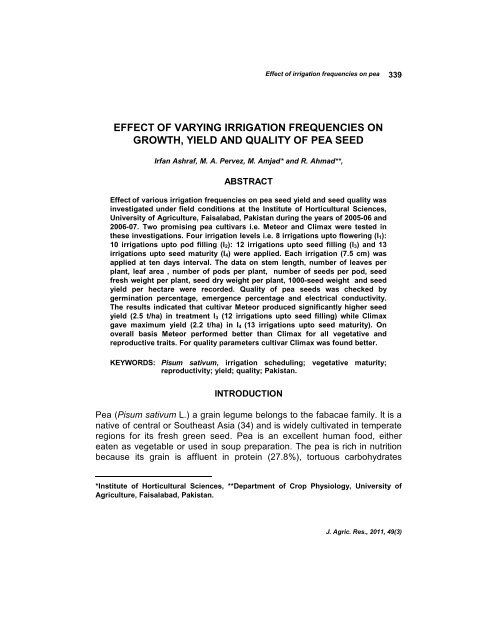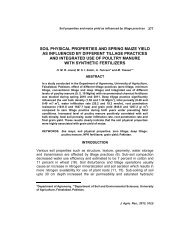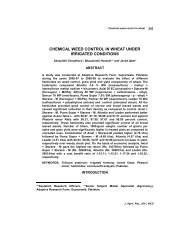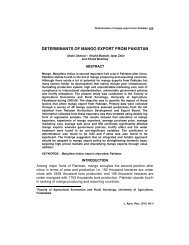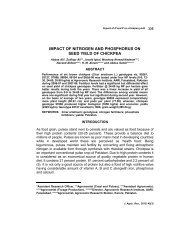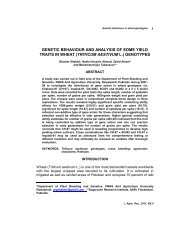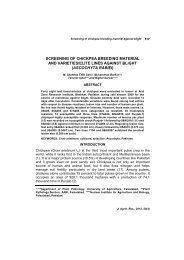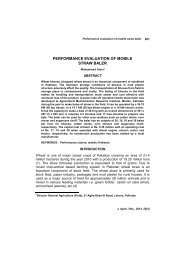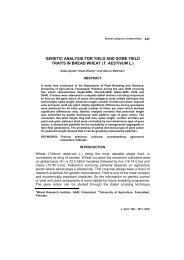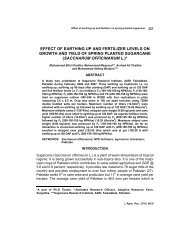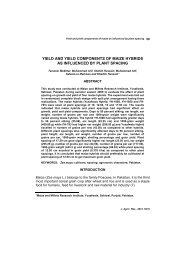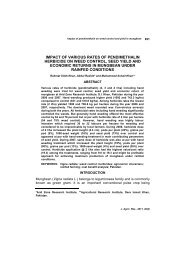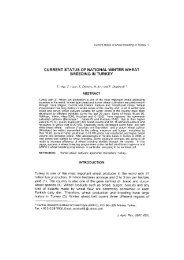Effect of varying Irrigation Frequencies on Growth, Yield and Quality ...
Effect of varying Irrigation Frequencies on Growth, Yield and Quality ...
Effect of varying Irrigation Frequencies on Growth, Yield and Quality ...
- No tags were found...
You also want an ePaper? Increase the reach of your titles
YUMPU automatically turns print PDFs into web optimized ePapers that Google loves.
<str<strong>on</strong>g>Effect</str<strong>on</strong>g> <str<strong>on</strong>g>of</str<strong>on</strong>g> irrigati<strong>on</strong> frequencies <strong>on</strong> pea<br />
339<br />
EFFECT OF VARYING IRRIGATION FREQUENCIES ON<br />
GROWTH, YIELD AND QUALITY OF PEA SEED<br />
Irfan Ashraf, M. A. Pervez, M. Amjad* <strong>and</strong> R. Ahmad**,<br />
ABSTRACT<br />
<str<strong>on</strong>g>Effect</str<strong>on</strong>g> <str<strong>on</strong>g>of</str<strong>on</strong>g> various irrigati<strong>on</strong> frequencies <strong>on</strong> pea seed yield <strong>and</strong> seed quality was<br />
investigated under field c<strong>on</strong>diti<strong>on</strong>s at the Institute <str<strong>on</strong>g>of</str<strong>on</strong>g> Horticultural Sciences,<br />
University <str<strong>on</strong>g>of</str<strong>on</strong>g> Agriculture, Faisalabad, Pakistan during the years <str<strong>on</strong>g>of</str<strong>on</strong>g> 2005-06 <strong>and</strong><br />
2006-07. Two promising pea cultivars i.e. Meteor <strong>and</strong> Climax were tested in<br />
these investigati<strong>on</strong>s. Four irrigati<strong>on</strong> levels i.e. 8 irrigati<strong>on</strong>s upto flowering (I 1):<br />
10 irrigati<strong>on</strong>s upto pod filling (I 2): 12 irrigati<strong>on</strong>s upto seed filling (I 3) <strong>and</strong> 13<br />
irrigati<strong>on</strong>s upto seed maturity (I 4) were applied. Each irrigati<strong>on</strong> (7.5 cm) was<br />
applied at ten days interval. The data <strong>on</strong> stem length, number <str<strong>on</strong>g>of</str<strong>on</strong>g> leaves per<br />
plant, leaf area , number <str<strong>on</strong>g>of</str<strong>on</strong>g> pods per plant, number <str<strong>on</strong>g>of</str<strong>on</strong>g> seeds per pod, seed<br />
fresh weight per plant, seed dry weight per plant, 1000-seed weight <strong>and</strong> seed<br />
yield per hectare were recorded. <strong>Quality</strong> <str<strong>on</strong>g>of</str<strong>on</strong>g> pea seeds was checked by<br />
germinati<strong>on</strong> percentage, emergence percentage <strong>and</strong> electrical c<strong>on</strong>ductivity.<br />
The results indicated that cultivar Meteor produced significantly higher seed<br />
yield (2.5 t/ha) in treatment I 3 (12 irrigati<strong>on</strong>s upto seed filling) while Climax<br />
gave maximum yield (2.2 t/ha) in I 4 (13 irrigati<strong>on</strong>s upto seed maturity). On<br />
overall basis Meteor performed better than Climax for all vegetative <strong>and</strong><br />
reproductive traits. For quality parameters cultivar Climax was found better.<br />
KEYWORDS: Pisum sativum, irrigati<strong>on</strong> scheduling; vegetative maturity;<br />
reproductivity; yield; quality; Pakistan.<br />
INTRODUCTION<br />
Pea (Pisum sativum L.) a grain legume bel<strong>on</strong>gs to the fabacae family. It is a<br />
native <str<strong>on</strong>g>of</str<strong>on</strong>g> central or Southeast Asia (34) <strong>and</strong> is widely cultivated in temperate<br />
regi<strong>on</strong>s for its fresh green seed. Pea is an excellent human food, either<br />
eaten as vegetable or used in soup preparati<strong>on</strong>. The pea is rich in nutriti<strong>on</strong><br />
because its grain is affluent in protein (27.8%), tortuous carbohydrates<br />
*Institute <str<strong>on</strong>g>of</str<strong>on</strong>g> Horticultural Sciences, **Department <str<strong>on</strong>g>of</str<strong>on</strong>g> Crop Physiology, University <str<strong>on</strong>g>of</str<strong>on</strong>g><br />
Agriculture, Faisalabad, Pakistan.<br />
J. Agric. Res., 2011, 49(3)
340<br />
I. Ashraf et al.<br />
(42.65%), vitamins, minerals, dietary fibres <strong>and</strong> antioxidant compounds (31).<br />
Peas rank fourth in the world <strong>on</strong> producti<strong>on</strong> basis (441.53 thous<strong>and</strong> t<strong>on</strong>s)<br />
am<strong>on</strong>g grain legumes after soybean, groundnut <strong>and</strong> french beans <strong>and</strong> is<br />
grown <strong>on</strong> an area <str<strong>on</strong>g>of</str<strong>on</strong>g> 528.71 thous<strong>and</strong> hectares in the world (4).<br />
In Pakistan, pea is an important crop <str<strong>on</strong>g>of</str<strong>on</strong>g> the Punjab province <strong>and</strong> enjoys a<br />
great commercial dem<strong>and</strong> for its nutritive value. It is cultivated <strong>on</strong> 10<br />
thous<strong>and</strong> hectares with a total producti<strong>on</strong> <str<strong>on</strong>g>of</str<strong>on</strong>g> 82 thous<strong>and</strong> t<strong>on</strong>s in Pakistan<br />
(3).<br />
Shortage <str<strong>on</strong>g>of</str<strong>on</strong>g> water is the most terrible c<strong>on</strong>straint for agricultural development<br />
in arid <strong>and</strong> semi-arid areas. Under these c<strong>on</strong>diti<strong>on</strong>s, dem<strong>and</strong> to use the<br />
available water ec<strong>on</strong>omically <strong>and</strong> expeditiously is unquesti<strong>on</strong>able in<br />
Pakistan. Acute shortage <str<strong>on</strong>g>of</str<strong>on</strong>g> irrigati<strong>on</strong> water <strong>and</strong> drought are adversely<br />
affecting crop producti<strong>on</strong> in general <strong>and</strong> vegetable producti<strong>on</strong> in particular.<br />
Fougereux et al. (10) reported that water stress during the flowering period<br />
<str<strong>on</strong>g>of</str<strong>on</strong>g> pea crop did not reduce seed quality but reduced seed yield slightly. They<br />
stated that pea seed yield was closely related to pod number per unit area,<br />
which was also str<strong>on</strong>gly related to water stress. Martin <strong>and</strong> Jamies<strong>on</strong> (15)<br />
found that number <str<strong>on</strong>g>of</str<strong>on</strong>g> seeds per pod was unaffected by water stress.<br />
Similarly, moisture stress during seed development can substantially<br />
decrease the amount <str<strong>on</strong>g>of</str<strong>on</strong>g> viable pea seed producti<strong>on</strong> (22). Mostly the<br />
research <strong>on</strong> irrigati<strong>on</strong> management for pea producti<strong>on</strong> has dealt with<br />
sensitivity to moisture stressed specific growth stages (21, 25). Pea yields<br />
<str<strong>on</strong>g>of</str<strong>on</strong>g>ten are increased by irrigati<strong>on</strong> during vegetative <strong>and</strong> reproductive growth,<br />
when soil moisture is otherwise limiting (11). However, few studies have<br />
examined the effects <str<strong>on</strong>g>of</str<strong>on</strong>g> irrigati<strong>on</strong> <strong>on</strong> spring pea seed yield (26, 34, 36) <strong>and</strong><br />
quality (5, 7, 12, 20). The effect <str<strong>on</strong>g>of</str<strong>on</strong>g> irrigati<strong>on</strong> has been reported by Salter<br />
(23, 24) at Wellesbourne, Warwickshire <strong>and</strong> in USA by Pumphrey <strong>and</strong><br />
Schwanke (21). Deficient irrigati<strong>on</strong> reduced seed yield more than excessive<br />
irrigati<strong>on</strong>, whereas excessive irrigati<strong>on</strong> caused the greatest reducti<strong>on</strong> <str<strong>on</strong>g>of</str<strong>on</strong>g> seed<br />
quality.<br />
In Pakistan, annual peas seed requirement is 588 t<strong>on</strong>s <strong>and</strong> due to n<strong>on</strong>availability<br />
<str<strong>on</strong>g>of</str<strong>on</strong>g> quality seed, the country is spending about Rs.159.00 milli<strong>on</strong><br />
<strong>on</strong> the import <str<strong>on</strong>g>of</str<strong>on</strong>g> peas seeds annually (2). Seed quality can be increased by<br />
careful management <str<strong>on</strong>g>of</str<strong>on</strong>g> seed crops in the field by wise irrigati<strong>on</strong> scheduling.<br />
J. Agric. Res., 2011, 49(3)
<str<strong>on</strong>g>Effect</str<strong>on</strong>g> <str<strong>on</strong>g>of</str<strong>on</strong>g> irrigati<strong>on</strong> frequencies <strong>on</strong> pea<br />
341<br />
This study was c<strong>on</strong>ducted to investigate the effect <str<strong>on</strong>g>of</str<strong>on</strong>g> irrigati<strong>on</strong> frequencies<br />
<strong>on</strong> growth, yield <strong>and</strong> quality <str<strong>on</strong>g>of</str<strong>on</strong>g> pea seed. In additi<strong>on</strong>, efforts were also made<br />
to determine the effect <str<strong>on</strong>g>of</str<strong>on</strong>g> irrigati<strong>on</strong> <strong>on</strong> physiological aspects <str<strong>on</strong>g>of</str<strong>on</strong>g> produced<br />
seed like germinati<strong>on</strong> capacity <strong>and</strong> vigour.<br />
MATERIALS AND METHODS<br />
This study was c<strong>on</strong>ducted at the Institute <str<strong>on</strong>g>of</str<strong>on</strong>g> Horticultural Sciences,<br />
University <str<strong>on</strong>g>of</str<strong>on</strong>g> Agriculture, Faisalabad, Pakistan during the year 2005-06 <strong>and</strong><br />
2006-07. Layout system for field experiments was RCBD with factorial<br />
arrangements <strong>and</strong> CRD was used for seed vigour tests in laboratory. Pea<br />
crop (cvs. Climax <strong>and</strong> Meteor) was sown <strong>on</strong> 2 nd November, 2005 at a<br />
distance <str<strong>on</strong>g>of</str<strong>on</strong>g> 20 cm <strong>on</strong> beds made 150 cm apart. Each sub-plot was 1.5 m<br />
wide <strong>and</strong> 5.71 m l<strong>on</strong>g (8.565 m 2 ). St<strong>and</strong>ard dose <str<strong>on</strong>g>of</str<strong>on</strong>g> N @ 80 kg per hectare<br />
al<strong>on</strong>gwith 120 kg P <strong>and</strong> 100 kg K was applied. Phosphorus, potash <strong>and</strong> half<br />
dose <str<strong>on</strong>g>of</str<strong>on</strong>g> nitrogen were applied at the time <str<strong>on</strong>g>of</str<strong>on</strong>g> seed bed preparati<strong>on</strong> <strong>and</strong><br />
remaining N was applied when flowering started. Immediately after sowing,<br />
water was applied. <str<strong>on</strong>g>Irrigati<strong>on</strong></str<strong>on</strong>g>s (7.5 cm each) were applied <strong>on</strong> different crop<br />
growth stages, with ten days intervals as per schedule comprising four<br />
treatments viz. 8 irrigati<strong>on</strong>s upto flowering (I 1 ), 10 irrigati<strong>on</strong>s upto pod filling<br />
(I 2 ), 12 irrigati<strong>on</strong>s upto seed filling (I 3 ) <strong>and</strong> 13 irrigati<strong>on</strong>s upto seed maturity<br />
stage (I 4 ). Crop was looked after properly <strong>and</strong> harvested <strong>on</strong> 22 nd May, 2006.<br />
Data <strong>on</strong> main stem length (cm), number <str<strong>on</strong>g>of</str<strong>on</strong>g> leaves per plant, leaf area (cm 2 ),<br />
number <str<strong>on</strong>g>of</str<strong>on</strong>g> pods per plant, number <str<strong>on</strong>g>of</str<strong>on</strong>g> seeds per pod, seed fresh weight per<br />
plant (g), seed dry weight per plant (g), 1000-seed weight (g) <strong>and</strong> seed yield<br />
per hectare (t<strong>on</strong>s) were recorded. The seed vigour tests like electrical<br />
c<strong>on</strong>ductivity, germinati<strong>on</strong> <strong>and</strong> emergence percentages were also performed.<br />
These tests were also performed after harvest <strong>and</strong> quality <str<strong>on</strong>g>of</str<strong>on</strong>g> seed was<br />
observed. Weather data were recorded for the year 2005-06 <strong>and</strong> 2006-07<br />
seas<strong>on</strong>s (Table 1). The year 2006-07 remained cooler because <str<strong>on</strong>g>of</str<strong>on</strong>g> higher<br />
rainfall which resulted in higher humidity <strong>and</strong> thus overall cooler envir<strong>on</strong>ment<br />
prevailed during sec<strong>on</strong>d year <str<strong>on</strong>g>of</str<strong>on</strong>g> the experiment.<br />
Table 1. Mean m<strong>on</strong>thly temperature (°C), relative humidity <strong>and</strong> total rainfall received<br />
during crop growth.<br />
Temperature (°C) Relative humidity (%) Rainfall (mm)<br />
M<strong>on</strong>ths 2005-06 2006-07 2005-06 2006-07 2005-06 2006-07<br />
Nov 20.8 20.9 50.5 47.0 0.0 12.8<br />
Dec 14.6 15.5 52.0 57.4 0.0 46.2<br />
J. Agric. Res., 2011, 49(3)
342<br />
I. Ashraf et al.<br />
Jan 13.5 12.5 58.1 67.4 8.2 0.0<br />
Feb 20.3 15.5 52.4 67.1 14.6 55.9<br />
Mar 21.4 19.4 40.7 47.0 37.0 41.3<br />
Apr 29.2 28.9 23.4 35.1 0.0 0.0<br />
May 34.8 32.2 23.9 25.0 24.0 0.0<br />
Source: Crop Physiology Department, Meteorological Stati<strong>on</strong>, University <str<strong>on</strong>g>of</str<strong>on</strong>g> Agriculture,<br />
Faisalabad.<br />
RESULTS AND DISCUSSION<br />
Main stem length (cm)<br />
The data (Table 2) revealed that <strong>on</strong> the basis <str<strong>on</strong>g>of</str<strong>on</strong>g> two years average, both the<br />
cultivars performed significantly better in I 3 treatment (12 irrigati<strong>on</strong>s upto<br />
seed filling). Meteor had more main stem length (58.0 cm) than Climax (55.0<br />
cm) in this treatment. Treatment I 4 (13 irrigati<strong>on</strong>s upto maturity) stood sec<strong>on</strong>d<br />
in case <str<strong>on</strong>g>of</str<strong>on</strong>g> both cultivars (Climax 54.9 cm <strong>and</strong> Meteor 54.5 cm), while I 1 (8<br />
irrigati<strong>on</strong>s upto flowering) produced the shortest stem length (Table 2). The<br />
data further showed that both cultivars produced higher stem length during<br />
sec<strong>on</strong>d year <str<strong>on</strong>g>of</str<strong>on</strong>g> study i.e. 2006-07 (Meteor 58.0 cm <strong>and</strong> Climax 57.2cm) due<br />
to higher rainfall. Availability <str<strong>on</strong>g>of</str<strong>on</strong>g> moisture to plants during the year 2006-07<br />
enhanced the plant health <strong>and</strong> vigour which resulted in more stem length.<br />
Similar findings have been reported by Hsio et al. (13) who observed that<br />
water stress was a limiting factor for proper plant growth. These results<br />
partially c<strong>on</strong>tradict the findings <str<strong>on</strong>g>of</str<strong>on</strong>g> Salter (23) who noted positive resp<strong>on</strong>se <str<strong>on</strong>g>of</str<strong>on</strong>g><br />
irrigati<strong>on</strong> till flowering in peas.<br />
Number <str<strong>on</strong>g>of</str<strong>on</strong>g> leaves per plant<br />
Significantly maximum number <str<strong>on</strong>g>of</str<strong>on</strong>g> leaves per plant was recorded in treatment<br />
I 3 (irrigati<strong>on</strong> upto seed filling stage) in case <str<strong>on</strong>g>of</str<strong>on</strong>g> both cultivars (Table 2). In this<br />
treatment Meteor had more number <str<strong>on</strong>g>of</str<strong>on</strong>g> leaves (67.1) than Climax (61.5)<br />
followed by treatment I 4 (irrigati<strong>on</strong> upto seed maturity stage) (65.5 in Meteor<br />
<strong>and</strong> 60.8 Climax). As far as years effect is c<strong>on</strong>cerned both cultivars gave<br />
more number <str<strong>on</strong>g>of</str<strong>on</strong>g> leaves in the year 2005-06 (64.0) <strong>and</strong> stood at par. The<br />
results further revealed that irrigati<strong>on</strong> upto flowering did not prove its worth.<br />
Vegetative growth was more sensitive to water stress than reproductive<br />
growth in peas. Peas are an indeterminate plant <strong>and</strong> flowering, pod filling<br />
<strong>and</strong> vegetative growth can occur simultaneously. There is competiti<strong>on</strong> for<br />
assimilate between these processes <strong>and</strong> the resp<strong>on</strong>se <str<strong>on</strong>g>of</str<strong>on</strong>g> yield comp<strong>on</strong>ents<br />
will vary according to the relative strengths <str<strong>on</strong>g>of</str<strong>on</strong>g> the sources <strong>and</strong> sinks for<br />
assimilates. Salter (24) <strong>and</strong> Maurer et al (17) found excessive vegetative<br />
J. Agric. Res., 2011, 49(3)
<str<strong>on</strong>g>Effect</str<strong>on</strong>g> <str<strong>on</strong>g>of</str<strong>on</strong>g> irrigati<strong>on</strong> frequencies <strong>on</strong> pea<br />
343<br />
growth where water stress was avoided. The present results are also in line<br />
with those <str<strong>on</strong>g>of</str<strong>on</strong>g> Hsio et al. (13) who reported that water stress during growing<br />
stage reduced the growth <str<strong>on</strong>g>of</str<strong>on</strong>g> pea plants.<br />
Leaf area (cm 2 )<br />
Results <str<strong>on</strong>g>of</str<strong>on</strong>g> leaf area (cm 2 ) were found similar to those <str<strong>on</strong>g>of</str<strong>on</strong>g> number <str<strong>on</strong>g>of</str<strong>on</strong>g> leaves<br />
per plant. Maximum leaf area was observed in treatment I 3 in case <str<strong>on</strong>g>of</str<strong>on</strong>g> both<br />
cultivars. Meteor cultivar had comparatively more leaf area (246.0 cm 2 ) than<br />
Climax (241.0 cm 2 ) (Table 2). These results are similar to those <str<strong>on</strong>g>of</str<strong>on</strong>g> Hsio et al<br />
(13) who reported that water stress reduces growth via affecti<strong>on</strong> cell<br />
expansi<strong>on</strong>. In experiments with two pea cultivars, Salter (23, 24) also<br />
observed a resp<strong>on</strong>se to irrigati<strong>on</strong> at flowering but not to applicati<strong>on</strong> <str<strong>on</strong>g>of</str<strong>on</strong>g> water<br />
in dry c<strong>on</strong>diti<strong>on</strong>s during the vegetative growth stage.<br />
Number <str<strong>on</strong>g>of</str<strong>on</strong>g> pods per plant<br />
In this trait also both cultivars produced more number <str<strong>on</strong>g>of</str<strong>on</strong>g> pods per plant<br />
(Meteor 25 <strong>and</strong> Climax 22.3) in I 3 i.e. irrigati<strong>on</strong>s upto seed filling stage<br />
followed by I 4 i.e . irrigati<strong>on</strong>s upto seed maturity in case <str<strong>on</strong>g>of</str<strong>on</strong>g> Meteor (23.5) <strong>and</strong><br />
I 2 in case <str<strong>on</strong>g>of</str<strong>on</strong>g> Climax (21.5) (Table 3). For years effect, Climax gave more<br />
number <str<strong>on</strong>g>of</str<strong>on</strong>g> pods per plant during the year 2005-06 (22.1) than the year 2006-<br />
07 (19.8). However, Meteor produced similar number <str<strong>on</strong>g>of</str<strong>on</strong>g> pods during both<br />
years (22.7) which was higher than Climax.<br />
<str<strong>on</strong>g>Irrigati<strong>on</strong></str<strong>on</strong>g> upto flowering (I 1 ) produced the lowest number <str<strong>on</strong>g>of</str<strong>on</strong>g> pods (17.2)<br />
during the year 2006-07. <str<strong>on</strong>g>Irrigati<strong>on</strong></str<strong>on</strong>g> at any growth stage increased the yield <str<strong>on</strong>g>of</str<strong>on</strong>g><br />
Meteor. The highest yields for this cultivar were achieved where irrigati<strong>on</strong><br />
was applied throughout the seas<strong>on</strong> but these results did not differ<br />
significantly from other irrigati<strong>on</strong> treatments where less water was applied.<br />
There was also a more effect <str<strong>on</strong>g>of</str<strong>on</strong>g> irrigati<strong>on</strong> <strong>on</strong> Meteor cultivar than Climax. .<br />
As in the previous year, Meteor was also more resp<strong>on</strong>sive to irrigati<strong>on</strong> at<br />
vegetative stage than Climax <strong>and</strong> overall. In this experiment, water stress<br />
might have a str<strong>on</strong>ger effect <strong>on</strong> reducing the number <str<strong>on</strong>g>of</str<strong>on</strong>g> pods/unit area than<br />
<strong>on</strong> leaf area development. The low yields were associated with low number<br />
<str<strong>on</strong>g>of</str<strong>on</strong>g> pods, nodes/stem <strong>and</strong> pods/node <strong>and</strong> a slower increase in pod weight<br />
(19). Whether these changes would affect the balance between sources <strong>and</strong><br />
sinks, is uncertain. The resulting source-sink relati<strong>on</strong>ships during the filling<br />
phase would then have been quite different for early <strong>and</strong> late drought plots<br />
experienced. C<strong>on</strong>sequently, there may have surplus photosynthates to fill<br />
the peas in treatments with low pea numbers perunit area despite less<br />
J. Agric. Res., 2011, 49(3)
344<br />
I. Ashraf et al.<br />
favourable c<strong>on</strong>diti<strong>on</strong>s for growth. Moisture stress during seed development<br />
can substantially decrease the amount <str<strong>on</strong>g>of</str<strong>on</strong>g> viable pea seed producti<strong>on</strong> (22).<br />
Martin <strong>and</strong> Jamies<strong>on</strong> (15) reported that water stress during the last half <str<strong>on</strong>g>of</str<strong>on</strong>g><br />
growing seas<strong>on</strong> (pollinati<strong>on</strong>, pod <strong>and</strong> seed formati<strong>on</strong> periods) was a major<br />
factor in reducing seed yield in temperate dry areas. Water stress during<br />
seed filling decreased seed yield <strong>and</strong> seed quality while, stress during seed<br />
filling reduced seed size (7), seed per unit area <strong>and</strong> yield can be reduced by<br />
short periods <str<strong>on</strong>g>of</str<strong>on</strong>g> stress during flowering <strong>and</strong> pod set (32).<br />
J. Agric. Res., 2011, 49(3)
<str<strong>on</strong>g>Effect</str<strong>on</strong>g> <str<strong>on</strong>g>of</str<strong>on</strong>g> irrigati<strong>on</strong> frequencies <strong>on</strong> pea<br />
345<br />
J. Agric. Res., 2011, 49(3)
346<br />
I. Ashraf et al.<br />
Number <str<strong>on</strong>g>of</str<strong>on</strong>g> seeds per pod<br />
On the basis <str<strong>on</strong>g>of</str<strong>on</strong>g> two years mean, cultivar Meteor produced more number <str<strong>on</strong>g>of</str<strong>on</strong>g><br />
seeds (6.1) in I 3 (12 irrigati<strong>on</strong>s upto pod filling stage) while Climax gave more<br />
seeds (5.6) in I 4 (13 irrigati<strong>on</strong>s upto seed maturity stage) (Table 3). As far as<br />
year effect is c<strong>on</strong>cerned, both cultivars gave higher number <str<strong>on</strong>g>of</str<strong>on</strong>g> seeds during<br />
the year 2006-07 where Meteor surpassed (6.5 seeds/pod) the Climax (6.0).<br />
During the year 2005-06 both these cultivars gave less number <str<strong>on</strong>g>of</str<strong>on</strong>g> seeds per<br />
pod i.e. Climax 4.3 <strong>and</strong> Meteor 4.6.<br />
Pea seed yield was closely related to pod number per unit area <strong>and</strong> water<br />
stress. The number <str<strong>on</strong>g>of</str<strong>on</strong>g> seeds per pod was unaffected by water stress (15).<br />
Water stress initiated during vegetative or early reproductive growth <str<strong>on</strong>g>of</str<strong>on</strong>g><br />
soybean usually reduced yield by reducing number <str<strong>on</strong>g>of</str<strong>on</strong>g> seeds per unit area<br />
(6), while stress during seed filling reduced seed size (7), seeds per unit<br />
area <strong>and</strong> yield can be reduced by short periods <str<strong>on</strong>g>of</str<strong>on</strong>g> stress during flowering<br />
<strong>and</strong> pod set (32). The major porti<strong>on</strong> <str<strong>on</strong>g>of</str<strong>on</strong>g> this yield reducti<strong>on</strong> was related to<br />
fewer seeds being produced (8, 12).<br />
1000-seed weight (g)<br />
In this trait, both cultivars performed significantly better in treatment I 4<br />
(irrigati<strong>on</strong>s upto seed maturity) (Meteor 251.5 <strong>and</strong> Climax 250.2 g) followed<br />
by I 3 (irrigati<strong>on</strong>s upto seed filling stage) (Meteor 242.5 <strong>and</strong> Climax 241.9 g)<br />
(Table 3). Increased water use efficiency with increasing water stress has<br />
also been observed in lentils by Mckenzie <strong>and</strong> Hill (18) reflecting the lower<br />
soil evaporati<strong>on</strong> comp<strong>on</strong>ent <str<strong>on</strong>g>of</str<strong>on</strong>g> water use without irrigati<strong>on</strong>. Water use<br />
efficiencies in this study are similar to those reported by Zain et al (37).<br />
Vieira et al. (33) reported yield reducti<strong>on</strong> <str<strong>on</strong>g>of</str<strong>on</strong>g> 35-41 percent when drought<br />
stress was imposed during seed filling in green house experiment but found<br />
no effect <strong>on</strong> germinati<strong>on</strong>. Drought stress resulted in significantly inferior<br />
quality seeds as compared to well watered c<strong>on</strong>trol plants. <str<strong>on</strong>g>Irrigati<strong>on</strong></str<strong>on</strong>g> during<br />
full reproductive period was required for maximum seed yield <strong>and</strong><br />
germinati<strong>on</strong> <str<strong>on</strong>g>of</str<strong>on</strong>g> harvested seed (12).<br />
Seed fresh weight per plant (g)<br />
Maximum seed fresh weight was noted in case <str<strong>on</strong>g>of</str<strong>on</strong>g> Meteor in treatment I 1<br />
(88.4 g) which was statistically similar to I 4 (88.2 g) (Table 4). However,<br />
J. Agric. Res., 2011, 49(3)
<str<strong>on</strong>g>Effect</str<strong>on</strong>g> <str<strong>on</strong>g>of</str<strong>on</strong>g> irrigati<strong>on</strong> frequencies <strong>on</strong> pea<br />
347<br />
Climax performed better in I 4 (89.0 g). For years effect, both cultivars <strong>on</strong> the<br />
basis <str<strong>on</strong>g>of</str<strong>on</strong>g> two years mean, gave more seed fresh weight during the year<br />
2006-07 as compared to 2005-06.<br />
Seed dry weight per plant (g)<br />
The data (Table 4) further showed that Meteor stood first for this trait in<br />
treatment I 4 (66.0 g) while Climax (65.1 g) ranked sec<strong>on</strong>d. It was followed by<br />
treatment I 3 (Meteor 64.5 <strong>and</strong> Climax 63.5 g). Treatment I 4 differed<br />
significantly from other irrigati<strong>on</strong> treatments in case <str<strong>on</strong>g>of</str<strong>on</strong>g> Climax but not in case<br />
<str<strong>on</strong>g>of</str<strong>on</strong>g> Meteor which yielded similar to I 1 <strong>and</strong> I 2 . The results also showed that<br />
both cultivars produced more dry weight during the year 2006-07. These<br />
results are in line with Vieira et al., (33) who reported a yield reducati<strong>on</strong> <str<strong>on</strong>g>of</str<strong>on</strong>g><br />
35-41 percent when drought stress was imposed during seed filling. When<br />
drought stress was imposed, significantly inferior quality seeds were<br />
produced as compared to well watered c<strong>on</strong>trol plants.<br />
Seed yield per hectare (T<strong>on</strong>s)<br />
On average basis seed, yield was maximum in case <str<strong>on</strong>g>of</str<strong>on</strong>g> Meteor (2.5 t) in<br />
treatment I 3 while Climax performed better (2.2 t) in treatment I 4 . As far as<br />
year effect is c<strong>on</strong>cerned, both cultivars produced more seed yield during the<br />
year 2006-07 where Meteor excelled (2.3 t) the cultivar Climax (2.1 t). In<br />
case <str<strong>on</strong>g>of</str<strong>on</strong>g> interacti<strong>on</strong>, Meteor produced more seed yield (2.8 t) during 2006-07<br />
in treatment I 3.<br />
<str<strong>on</strong>g>Irrigati<strong>on</strong></str<strong>on</strong>g> at flowering <strong>and</strong> again at pod filling represented the traditi<strong>on</strong>al<br />
irrigati<strong>on</strong> recommendati<strong>on</strong> for dry peas grown <strong>on</strong> heavier soils (28). The low<br />
yields were associated with low number <str<strong>on</strong>g>of</str<strong>on</strong>g> pods, nodes per stem <strong>and</strong> pods<br />
per node <strong>and</strong> a slower increase in pod weight (19). In these experiments,<br />
irrigati<strong>on</strong> at any growth stage increased yield but the highest yield for both<br />
cultivars were achieved where water stress was completely eliminated by<br />
irrigating upto seed filling stage where yield was significantly higher than<br />
those achieved by other irrigati<strong>on</strong> treatments.<br />
Electrical c<strong>on</strong>ductivity (µ/g)<br />
On the basis <str<strong>on</strong>g>of</str<strong>on</strong>g> two years average, maximum electrical c<strong>on</strong>ductivity was<br />
found in both cultivars in I 3 (Meteor 23.4 <strong>and</strong> Climax 22.9 us/g) followed by<br />
treatment I 2 (Meteor 22.6 <strong>and</strong> Climax 22.3 us/g) (Table 5). As far as years<br />
J. Agric. Res., 2011, 49(3)
348<br />
I. Ashraf et al.<br />
effect is c<strong>on</strong>cerned, both cultivars gave more electrical c<strong>on</strong>ductivity during<br />
the year 2006-07 (Meteor 24.2 <strong>and</strong> Climax 23.9 us/g).<br />
Seed yield <strong>and</strong> viability can be reduced by envir<strong>on</strong>mental stress. Little<br />
informati<strong>on</strong> is available c<strong>on</strong>cerning the effect <str<strong>on</strong>g>of</str<strong>on</strong>g> envir<strong>on</strong>mental stress <strong>on</strong><br />
seed quality (30). Unfavourable envir<strong>on</strong>mental c<strong>on</strong>diti<strong>on</strong>s during seed<br />
development <strong>and</strong> maturati<strong>on</strong> reduced viability <strong>and</strong> vigour. Envir<strong>on</strong>mental<br />
stress during seed producti<strong>on</strong> can affect subsequently seed quality. Stress<br />
occurring after physiological maturity, but before harvest can cause<br />
reducti<strong>on</strong> in soybean seed germinati<strong>on</strong> <strong>and</strong> vigour (30, 32, 33). Soybean<br />
seeds that experienced hot <strong>and</strong> dry weather during maturati<strong>on</strong> exhibited<br />
reduced laboratory germinati<strong>on</strong> <strong>and</strong> field emergence. Severe drought that<br />
occurred throughout seed filling reduced yield <strong>and</strong> seed number at a faster<br />
rate than seed mass, germinati<strong>on</strong> or vigour <strong>and</strong> maintained the development<br />
<str<strong>on</strong>g>of</str<strong>on</strong>g> some viable <strong>and</strong> vigorous seed. Nichols et al. (20) working with potted<br />
pea plants observed no effect <str<strong>on</strong>g>of</str<strong>on</strong>g> drought stress <strong>on</strong> seed c<strong>on</strong>ductivity or<br />
germinati<strong>on</strong>. Matthews <strong>and</strong> Bradnock (16) proposed the use <str<strong>on</strong>g>of</str<strong>on</strong>g> this test for<br />
pea seeds <strong>and</strong> the procedure has been st<strong>and</strong>ardized by the Processors <strong>and</strong><br />
Growers Research Organizati<strong>on</strong> (P.G.R.O., 1981).<br />
Seed germinati<strong>on</strong> (%)<br />
Germinati<strong>on</strong> test showed that treatment I 4 excelled in seed germinati<strong>on</strong> in<br />
case <str<strong>on</strong>g>of</str<strong>on</strong>g> both cultivars (Climax 96.1 <strong>and</strong> Meteor 94.5%) followed by I 2 (Climax<br />
93.3 <strong>and</strong> Meteor 91.1%) (Table 5). For the years effect. seed germinati<strong>on</strong><br />
was better during the year 2005-06 (Climax 94.0 <strong>and</strong> Meteor 92.5%) as<br />
compared to the year 2006-07 (Climax 93.2 <strong>and</strong> Meteor 90.2%).<br />
Simiciklas et al. (26) menti<strong>on</strong>ed that drought stress can lower seed quality<br />
<strong>and</strong> germinati<strong>on</strong> <str<strong>on</strong>g>of</str<strong>on</strong>g> seeds <str<strong>on</strong>g>of</str<strong>on</strong>g> soybean if applied during various stages <str<strong>on</strong>g>of</str<strong>on</strong>g><br />
flowering <strong>and</strong> seed development. Stress occurring after physiological<br />
maturity but before harvest can cause reducti<strong>on</strong> in soybean seed<br />
germinati<strong>on</strong> <strong>and</strong> vigour (8, 30, 32, 33). Heatherley (12) observed that<br />
drought stress resulted in reduced germinati<strong>on</strong> <str<strong>on</strong>g>of</str<strong>on</strong>g> harvested soybean. The<br />
results <str<strong>on</strong>g>of</str<strong>on</strong>g> germinati<strong>on</strong> were seedlings which may be normal or abnormal.<br />
The percentage <str<strong>on</strong>g>of</str<strong>on</strong>g> normal, healthy <strong>and</strong> vigorous seedlings produced under<br />
optimal c<strong>on</strong>diti<strong>on</strong>s in the laboratory.<br />
Emergence percentage<br />
J. Agric. Res., 2011, 49(3)
<str<strong>on</strong>g>Effect</str<strong>on</strong>g> <str<strong>on</strong>g>of</str<strong>on</strong>g> irrigati<strong>on</strong> frequencies <strong>on</strong> pea<br />
349<br />
Maximum emergence <str<strong>on</strong>g>of</str<strong>on</strong>g> seedlings was found in treatment I 3 (Climax 97.5%<br />
<strong>and</strong> Meteor 93.0%) (Table 5). A field emergence percentage test gives<br />
informati<strong>on</strong> about seed vigour <strong>and</strong> gives more accurate data to predict the<br />
storability <str<strong>on</strong>g>of</str<strong>on</strong>g> seed lot tested. If the field c<strong>on</strong>diti<strong>on</strong>s are optimal, the results<br />
<str<strong>on</strong>g>of</str<strong>on</strong>g><br />
J. Agric. Res., 2011, 49(3)
350<br />
I. Ashraf et al.<br />
J. Agric. Res., 2011, 49(3)
<str<strong>on</strong>g>Effect</str<strong>on</strong>g> <str<strong>on</strong>g>of</str<strong>on</strong>g> irrigati<strong>on</strong> frequencies <strong>on</strong> pea<br />
351<br />
emergence test usually correlate well with field emergence (1, 9, 29), but<br />
under suboptimal field c<strong>on</strong>diti<strong>on</strong>s, the laboratory germinati<strong>on</strong> results <str<strong>on</strong>g>of</str<strong>on</strong>g>tenly<br />
in overestimating the actual field emergence <str<strong>on</strong>g>of</str<strong>on</strong>g> seed lots (14, 29, 36). There<br />
can be c<strong>on</strong>siderable differences between the laboratory germinati<strong>on</strong> <str<strong>on</strong>g>of</str<strong>on</strong>g> a<br />
seed lot <strong>and</strong> its emergence in the field.<br />
CONCLUSION<br />
From the results <str<strong>on</strong>g>of</str<strong>on</strong>g> two years investigati<strong>on</strong>s, it is c<strong>on</strong>cluded that cultivar<br />
Meteor when irrigated upto seed filling (I 3 ) performed better than Climax<br />
under Faisalabad c<strong>on</strong>diti<strong>on</strong>s during both the years.<br />
REFERENCES<br />
1. Abdalla, F.H. E.H <strong>and</strong> Roberts. 1969. The effect <str<strong>on</strong>g>of</str<strong>on</strong>g> storage <strong>on</strong> growth<br />
<strong>and</strong> yield <str<strong>on</strong>g>of</str<strong>on</strong>g> barley, broad beans <strong>and</strong> peas. Annals <str<strong>on</strong>g>of</str<strong>on</strong>g> Botany. 33: 169-<br />
184.<br />
2. An<strong>on</strong>. 2008. Agricultural Statistics <str<strong>on</strong>g>of</str<strong>on</strong>g> Pakistan. Ministry <str<strong>on</strong>g>of</str<strong>on</strong>g> Food,<br />
Agri. <strong>and</strong> Livestock. Govt. <str<strong>on</strong>g>of</str<strong>on</strong>g> Pakistan. Islamabad. p. 152-153.<br />
3. An<strong>on</strong>. 2010. Agricultural Statistics <str<strong>on</strong>g>of</str<strong>on</strong>g> Pakistan. Ministry <str<strong>on</strong>g>of</str<strong>on</strong>g> Food,<br />
Agri. <strong>and</strong> Livestock. Govt. <str<strong>on</strong>g>of</str<strong>on</strong>g> Pakistan, Islamabad. p. 154-155.<br />
4. Bedford, L.V. 1974. C<strong>on</strong>ductivity tests in commercial <strong>and</strong> h<strong>and</strong><br />
harvested seed <str<strong>on</strong>g>of</str<strong>on</strong>g> pea cultivars <strong>and</strong> their relati<strong>on</strong> to field<br />
establishment. Seed Sci. Technol. 2: 332-335.<br />
5. Biddle, A.J. <strong>and</strong> J.M. King. 1978. <str<strong>on</strong>g>Effect</str<strong>on</strong>g> <str<strong>on</strong>g>of</str<strong>on</strong>g> harvesting methods,<br />
equipment <strong>and</strong> weather <strong>on</strong> pea seed quality. Acta Hort. 83: 77-81.<br />
6. Brevedan, R.E. <strong>and</strong> D.B. Egli. 2003. Short period <str<strong>on</strong>g>of</str<strong>on</strong>g> water stress during<br />
seed filling, leaf senescence <strong>and</strong> yield <str<strong>on</strong>g>of</str<strong>on</strong>g> soybean. Crop Scie., 43:<br />
2083-2088.<br />
7. De Souza, P.I., D.B Egli <strong>and</strong> W.P Bruening. 1997. Water stress during<br />
seed filling <strong>and</strong> leaf senescence in soybean. Agr<strong>on</strong>omy J. 89: 807-812.<br />
8. Dornbos, D.L., Jr., R.E. Mullen <strong>and</strong> R.M. Shibblies. 1989. Crop<br />
Science, 29: 476-480.<br />
9. Egli, D.B. <strong>and</strong> D.M. Tekr<strong>on</strong>y. 1979. Relati<strong>on</strong>ship between soybean<br />
seed vigour <strong>and</strong> yield. Agro. J. 71: 755-759.<br />
10. Fougereux, J.A., D. Thierry, F. Lad<strong>on</strong>ne <strong>and</strong> A. Fleury. 1997. Water<br />
stress during reproductive stages affects seed quality <strong>and</strong> yield <str<strong>on</strong>g>of</str<strong>on</strong>g> pea.<br />
Crop Sci. 37: 1247-1252.<br />
11. Heath, M. C., C.J. Pilbeam, B.A. McKenzie <strong>and</strong> P. D. Hebblethwaite,<br />
1994. In: Exp<strong>and</strong>ing the Producti<strong>on</strong> <strong>and</strong> Use <str<strong>on</strong>g>of</str<strong>on</strong>g> Cool Seas<strong>on</strong> Food<br />
Legumes (eds.) Muehlbauer, F. J. <strong>and</strong> Kaiser, W. J.) (Kluwer Academic<br />
J. Agric. Res., 2011, 49(3)
352<br />
I. Ashraf et al.<br />
Publishers, Dordrecht, Netherl<strong>and</strong>s. pp: 771-790.<br />
12. Heatherley, L.G. 1993. Drought stress <strong>and</strong> irrigati<strong>on</strong> effects <strong>on</strong><br />
germinati<strong>on</strong> <str<strong>on</strong>g>of</str<strong>on</strong>g> harvested soybean seed. Crop Sci. 33: 777-781.<br />
13. Hsio, T.C., W.K. Silk <strong>and</strong> J. Jing. 1985. Leaf growth <strong>and</strong> water deficits:<br />
Biophysical effects. In: C<strong>on</strong>trol <str<strong>on</strong>g>of</str<strong>on</strong>g> Leaf <strong>Growth</strong>, N.R. Baker, W.J.<br />
Davies <strong>and</strong> C.K. Ong (eds). Cambridge Univ. Press, Cambridge, p:<br />
239-266.<br />
14. Johns<strong>on</strong>, R.R. <strong>and</strong> L.M. Wax. 1978. Relati<strong>on</strong>ship <str<strong>on</strong>g>of</str<strong>on</strong>g> soybean<br />
germinati<strong>on</strong> <strong>and</strong> vigour test to field performance. Agr<strong>on</strong>. J., 70: 173-<br />
178.<br />
15. Martin, R.J. <strong>and</strong> P.D. Jamies<strong>on</strong>. 1996. <str<strong>on</strong>g>Effect</str<strong>on</strong>g> <str<strong>on</strong>g>of</str<strong>on</strong>g> timing <strong>and</strong> intensity <str<strong>on</strong>g>of</str<strong>on</strong>g><br />
drought <strong>on</strong> the growth <strong>and</strong> yield <str<strong>on</strong>g>of</str<strong>on</strong>g> field pea (Pisum sativum L.). N.Z. J.<br />
Crop Hort. Sci. 24: 167-174.<br />
16. Matthews, S. <strong>and</strong> W.T. Bradnock, 1967. The detecti<strong>on</strong> <str<strong>on</strong>g>of</str<strong>on</strong>g> seed<br />
samples <str<strong>on</strong>g>of</str<strong>on</strong>g> wrinkle-seed peas <str<strong>on</strong>g>of</str<strong>on</strong>g> low planting value. Internati<strong>on</strong>al Seed<br />
Testing Associati<strong>on</strong> 32: 553-5563.<br />
17. Maurer, A.R., D.P. Orm<strong>on</strong>d <strong>and</strong> H.F. Fletcher. 1968. Resp<strong>on</strong>se peas to<br />
envir<strong>on</strong>ment. IV. <str<strong>on</strong>g>Effect</str<strong>on</strong>g> <str<strong>on</strong>g>of</str<strong>on</strong>g> five soil water regimes <strong>on</strong> growth <strong>and</strong><br />
development <str<strong>on</strong>g>of</str<strong>on</strong>g> peas. Can. J. Pl. Sci., 48: 129-136.<br />
18. McKenzie, B.A. <strong>and</strong> G.D. Hill. 1990. <strong>Growth</strong>, yield <strong>and</strong> water use <str<strong>on</strong>g>of</str<strong>on</strong>g><br />
lentils (Lens culinaris) in Canterbury, NZ.J Agric., Sci. Cambridge 114:<br />
309-320.<br />
19. Milbourn, G.M. <strong>and</strong> R.C. Hardwick. 1968. The growth <str<strong>on</strong>g>of</str<strong>on</strong>g> vining peas.<br />
The effect <str<strong>on</strong>g>of</str<strong>on</strong>g> time <str<strong>on</strong>g>of</str<strong>on</strong>g> sowing. Agri. Sci., 20(3): 393-402.<br />
20. Nichols, M.A., I.J. Warringt<strong>on</strong> <strong>and</strong> D.J. Scott. 1978. Pre-harvest<br />
treatment effects <strong>on</strong> some quality criteria <str<strong>on</strong>g>of</str<strong>on</strong>g> pea seeds. Acta Hort., 83:<br />
113-124.<br />
21. Pumphrey, F.V. <strong>and</strong> R.K. Schwanke. 1974. <str<strong>on</strong>g>Effect</str<strong>on</strong>g>s <str<strong>on</strong>g>of</str<strong>on</strong>g> irrigati<strong>on</strong> <strong>on</strong><br />
growth, yield <strong>and</strong> quality <str<strong>on</strong>g>of</str<strong>on</strong>g> peas for processing. J. Amer. Soc. Hort.<br />
Sci., 99: 104-106.<br />
22. Raym<strong>on</strong>d, M.A. <strong>and</strong> C.S. Jeffrey. 1987. <str<strong>on</strong>g>Irrigati<strong>on</strong></str<strong>on</strong>g> management effects<br />
<strong>on</strong> spring pea seed yield <strong>and</strong> quality. Hort Sci., 22(6): 1262-1263.<br />
23. Salter, P.J. 1962. Some resp<strong>on</strong>ses <str<strong>on</strong>g>of</str<strong>on</strong>g> peas to irrigati<strong>on</strong> at different<br />
growth stages. J. Hort. Sci. 37: 141-149.<br />
24. Salter, P.J. 1963. The effect <str<strong>on</strong>g>of</str<strong>on</strong>g> wet <strong>and</strong> dry soil c<strong>on</strong>diti<strong>on</strong> at different<br />
stages <strong>on</strong> the comp<strong>on</strong>ents <str<strong>on</strong>g>of</str<strong>on</strong>g> yield <str<strong>on</strong>g>of</str<strong>on</strong>g> a pea crop. J. Hort. Sci. 38: 321-<br />
334.<br />
25. Salter, P.J. <strong>and</strong> J.B. Williams. 1967. The effect <str<strong>on</strong>g>of</str<strong>on</strong>g> irrigati<strong>on</strong> <strong>on</strong> pea<br />
crops grown different plant densities. J. Hort. Sci., 42: 59-66.<br />
26. Simiciklas, K.D., R.E. Mullen, R.E. Carls<strong>on</strong> <strong>and</strong> A.D. Knapp. 1989.<br />
J. Agric. Res., 2011, 49(3)
<str<strong>on</strong>g>Effect</str<strong>on</strong>g> <str<strong>on</strong>g>of</str<strong>on</strong>g> irrigati<strong>on</strong> frequencies <strong>on</strong> pea<br />
353<br />
Drought induced stress effects <strong>on</strong> soybean seed calcium <strong>and</strong> seed<br />
quality. Crop Sci. 29: 1519-1523.<br />
27. Stoker, R. 1977. <str<strong>on</strong>g>Irrigati<strong>on</strong></str<strong>on</strong>g> <str<strong>on</strong>g>of</str<strong>on</strong>g> garden peas <strong>on</strong> a good cropping soil. N.Z.<br />
J. Expt. Agr. 5: 233-236.<br />
28. Stoker, R. 1979. Peas for threshing: cultivars, requirements <strong>and</strong><br />
husb<strong>and</strong>ry. Agr. Link FPP 350 New Zeal<strong>and</strong> Ministry <str<strong>on</strong>g>of</str<strong>on</strong>g> Agriculture <strong>and</strong><br />
Fisheries. Pp: 3.<br />
29. Tekr<strong>on</strong>y, D.M. <strong>and</strong> D.B. Egli. 1977. Relati<strong>on</strong>ship between laboratory<br />
indices <str<strong>on</strong>g>of</str<strong>on</strong>g> soybean seed vigour <strong>and</strong> field emergence. Crop Sci., 17:<br />
573-577.<br />
30. TeKr<strong>on</strong>y, D.M., D.B. Egli <strong>and</strong> A.D. Ohillips. 1980. <str<strong>on</strong>g>Effect</str<strong>on</strong>g> <str<strong>on</strong>g>of</str<strong>on</strong>g> field<br />
weathering <strong>on</strong> the viability <strong>and</strong> vigour <str<strong>on</strong>g>of</str<strong>on</strong>g> soybean seed. Agr<strong>on</strong>. J., 72:<br />
749-753.<br />
31. Urbano, G., P. Ar<strong>and</strong>a <strong>and</strong> E. Gomez-Villalva. 2003. Nutriti<strong>on</strong>al<br />
evaluati<strong>on</strong> <str<strong>on</strong>g>of</str<strong>on</strong>g> pea (Pisum sativum L.) protein diets after mild<br />
hydrothermal treatment <strong>and</strong> with <strong>and</strong> without added phytase. J. Agri.<br />
Food Chem., 51: 2415–2420.<br />
32. Vieira, R.D., B.M. Tekor<strong>on</strong>y <strong>and</strong> D.B. Egli. 1992. <str<strong>on</strong>g>Effect</str<strong>on</strong>g> <str<strong>on</strong>g>of</str<strong>on</strong>g> drought <strong>and</strong><br />
defoliati<strong>on</strong> stress in the field <strong>on</strong> soybean seed germinati<strong>on</strong> <strong>and</strong> vigour.<br />
Crop Sci. 32: 471-475.<br />
33. Vieira, R.D., D.M. Tekr<strong>on</strong>y <strong>and</strong> D.B. Egli. 1991. <str<strong>on</strong>g>Effect</str<strong>on</strong>g>s <str<strong>on</strong>g>of</str<strong>on</strong>g> drought<br />
stress <strong>on</strong> soybean germinati<strong>on</strong> <strong>and</strong> vigour. J. Seed Technol., 15: 12-<br />
21.<br />
34. Warren, B.M., El. Russel, G.W. David <strong>and</strong> O. S. Harry. 1956.<br />
Vegetables <strong>and</strong> fruit growing. J.B. Chicago., 2:192-193.<br />
35. White, J.C.H., G.W. Sheath <strong>and</strong> G. Meiger. 1982. <strong>Yield</strong> <str<strong>on</strong>g>of</str<strong>on</strong>g> garden<br />
peas-field resp<strong>on</strong>ses to variati<strong>on</strong> in sowing rate <strong>and</strong> irrigati<strong>on</strong>. N.Z. J.<br />
Expt. Agri. 10: 155-160.<br />
36. Yaklich, R.W. <strong>and</strong> M.M. Kulik. 1979. Evaluati<strong>on</strong> <str<strong>on</strong>g>of</str<strong>on</strong>g> vigour tests in<br />
soybean seeds: relati<strong>on</strong>ship <str<strong>on</strong>g>of</str<strong>on</strong>g> the st<strong>and</strong>ard germinati<strong>on</strong> test, seedling<br />
vigour classificati<strong>on</strong>, seedling length <strong>and</strong> tetrazolium staining to field<br />
performance. Crop Sci., 19: 247-252.<br />
37. Zain, Z.M., J.N. Gallagher, J.G.H. White <strong>and</strong> J.B. Reid. 1983. The<br />
effect <str<strong>on</strong>g>of</str<strong>on</strong>g> irrigati<strong>on</strong> <strong>on</strong> radiati<strong>on</strong> absorpti<strong>on</strong>, water use <strong>and</strong> yield <str<strong>on</strong>g>of</str<strong>on</strong>g><br />
c<strong>on</strong>venti<strong>on</strong>al <strong>and</strong> semi-leafless peas. Proc. Ann. C<strong>on</strong>f. Agr<strong>on</strong>. Soc.<br />
N.Z. 13: 95-102.<br />
J. Agric. Res., 2011, 49(3)


